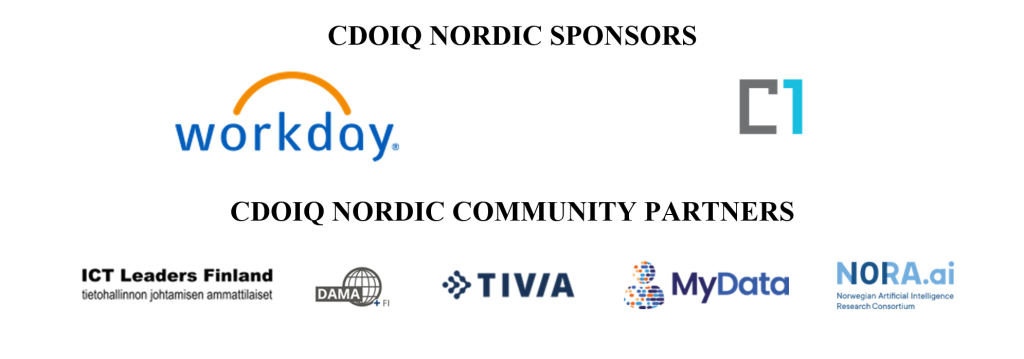
Successful Data Leadership: Lessons Learned from the CDOIQ Nordic Community Pre-Summit 2024
On May 16th, several non-profit organizations organized the first-ever CDOIQ Nordic Community Pre-Summit to share their thoughts on strategic data leadership and data economy. According to experienced data leaders, the key factors for successful Data Leadership are Systems Thinking, Data Quality by Design, and Empowering Business Leaders.
The Content of the Community Pre-Summit
During the morning sessions, speakers from various industries, ranging from manufacturing to healthcare, shared their insights on the empirical challenges and potential solutions associated with leading and sharing data. This article delves deeper into these topics.
Before lunch, participants engaged in a Data Leadership Self-Assessment Survey. This brief survey was designed to stimulate discussion among business, technology, and data leaders on the critical issues necessary for success in data-driven business improvement and innovation.
In the afternoon, speakers introduced practical frameworks that have enabled numerous companies to enhance collaboration among their business, data, and ICT stakeholders. We will publish soon also an article about these Practical Frameworks to Succeed as a Data-Driven Company.
The CDOIQ Nordic Community Pre-Summit was organized by CDOIQ Nordic Community Partners, such as ICT Leaders Finland ry and DAMA Finland ry, theme associations of the Finnish Information Processing Association, and MyData Global, an award-winning international association gathering data activists who aim for a more fair, sustainable, and prosperous digital society for all. The event was hosted by Aalto University Executive Education and Professional Development and sponsored by Cloud1 and Workday.

Lessons Learned for Successful Data Leadership
During the morning sessions, speakers from various industries, ranging from manufacturing to healthcare, shared their insights on the empirical challenges and potential solutions associated with leading and sharing data. A common theme emerged: the necessity of moving beyond optimizing data in silos to adopting a broader, cross-functional process perspective.
Speakers:
- Pirkko Kortekangas, Chief Specialist, UNA
- Risto Silvola, Director of IT, Product and Supply, Konecranes
- Kimmo Kontra, Independent Advisor
- Katja Tolkki,ESG Advisor, Orthex
- Taru Rastas, Lead Specialist, Sitra
- Anna Wennäkoski, Senior Specialist, LVM
- Tommi Vihervaara, Chief Data Architect, Posti Group
- Sameli Mäenpää, CEO, Blackbelts
- Pekka Pajuoja, CIO, Business Finland
In the healthcare sector, for example, data should be standardized across clinical pathways to optimize patient wellbeing and health outcomes, rather than focusing narrowly on individual services within fragmented provider networks. Similarly, in manufacturing, data should flow seamlessly across business supply chains to ensure successful collaboration within supplier ecosystems and compliance with forthcoming ESG (Environmental, Social, and Governance) reporting requirements.
One application of this ecosystem-wide supply chain data is the Digital Product Passport (DPP). DPPs collect data across the supply chain from all relevant participants, creating a summary of products’ lifecycle properties to inform users and verify compliance with forthcoming sustainability regulations. According to Taru Rastas from Sitra, this concept has already been tested in the textile, steel, and battery manufacturing industries.
The cross-functional perspective is critical because data is often created by individual business functions to serve their immediate needs. Alternatively, data might be manually replicated and aggregated for various administrative purposes, such as healthcare registry research or ESG compliance, leading to inefficient data management processes. As a result, the source data is too fragmented, heterogeneous, and low-quality to enable reliable automation, advanced analytics, and artificial intelligence. Instead, data should be created precisely in the original source data creation situations and supplemented with automatically generated context metadata to support its reuse and sharing for different purposes.
However, while organizations strive to adopt these best practices, the experts reminded us that experience has shown that organizations cannot leap over several maturity levels. Overhauling business processes and software systems to ensure accurate data creation from the start might not be feasible for business leaders or they might lack the resources to implement such radical transformations. In practice, organizations may first need to model and map their data with intermediary abstraction layers for specific business purposes, such as ESG reporting, national healthcare registries, or international epidemiological statistics.
For example, currently European Data Spaces must make decisions on their internal data models and standards. Particularly, Healthcare Data Space is now making decisions whether to settle for technical interoperability standards (e.g. HL7 FHIR), or should they require more semantic interoperability with administrative research-oriented reference data models (e.g. OMOP), or go even further towards standardized data creation with vendor-independent data models (OpenEHR). Similar foundational and strategic data domain decisions must be made by all industry sectors and their business ecosystems when designing their industry specific data spaces.
Even with this intermediary approach, such as healthcare registry research or ESG reporting, data should be designed to serve these additional business purposes at the time of data creation rather than trying to merge fragmented data sources to shared data models by using manual data collection and point-to-point integrations. According to Kontra and Tolkki, this could be done by adopting shared glossaries and reference data models, focusing on audit trails at the batch level, and distributing accountability with contractually enforced data products. However, this approach leaves always room for variations in the source data creation, which will lead to undesirable biases to such administrative data sets. The context metadata, pointed out by Kortekangas, is needed to make these hidden variations visible so other users could recognize, assess, and maybe even counter their effects.
Finally, a crucial lesson for data leaders was shared by Sameli Mäenpää, ex-Chief Data Officer of the OP Financial Group. Data leaders must first deliver valuable business results and demonstrate their worth to business leaders before they can hope to make a broader impact. Therefore, they should help the first one of the business leaders to achieve a data-driven business victory. Once they do, other business leaders will want to collaborate and secure a place in the top-performing executive team. With the support of business leaders, data leaders will have a better chance of influencing foundational factors, such as accurate data creation and redesign of core business processes, necessary for a comprehensive business transformation towards data-sharing ecosystems that apply advanced analytics, automation, and artificial intelligence to optimize cross-organizational business supply chains.
Read the more structured summary of the empirical challenges, recommended principles, and practical steps in the appendix.
Conclusion
The pre-summit provided us with a wealth of knowledge on the importance of cross-functional systems thinking, data quality by design and practical steps for data leaders to succeed in their mission. Data leaders should promote accurate data creation, automated context metadata generation, and integrated data flows internally across units and externally between enterprises. In this way, organizations could build a trustworthy data foundation to improve the validity of decision-making, automate manual data management processes, and adopt emerging artificial intelligence solutions. In practice, these capabilities must be built gradually, starting with successful showcases, updating existing business processes, and only later fully redesigning the core business systems. Adopting these best practices will enable businesses to fully harness the power of data and drive sustainable growth and improved profitability.
The Forthcoming CDOIQ Nordic Symposium 2025
This Community Pre-Summit was a pre-event for the CDOIQ Nordic Symposium 2025, that will be an exceptional opportunity for Nordic data leaders to learn from their peers, improve their careers and support their employers for three reasons.

We recommend everyone to promote the forthcoming CDOIQ Nordic Symposium for all data and digitalization leaders and strategists – regardless of their titles. Next year, they can experience an exceptionally high-level program and get a unique honour to be one of the founding participants establishing a new peer community for data leaders in the Nordic region.
Networking: The CDOIQ is a global community of data leaders, for data leaders, by data leaders born out of the MIT research and industry programs.
Knowledge: In the CDOIQ events, data leaders share their experiences, lessons learned, and cutting-edge ideas around the globe.
Impact: The CDOIQ mission is to strengthen the role of CDO, improve data leaders career progress, and help organizations gain more value from their data.
Read more or register to the Symposium here (Link)
This article is a personal interpretation and synthesis of the author rather than an exact description of each individual presentation.

The author, MSc Sami Laine, is a Senior Advisor at Aalto EE, where he is currently spearheading the mission to bring the world-renowned CDOIQ Symposium to the Nordics in 2025. During his over 20 years career, he has worked in data management practitioner, consultant, researcher, and teacher roles in several business sectors. Throughout his career, Sami has been an active advocate for promoting quality and ethical perspectives in data management and business decision-making, as recognized by his nomination for the DAIR Awards AI Ethics Professional of the year in 2022. He has been a long-time president and board member of the DAMA Finland ry and a program committee member of the MIT CDOIQ Symposium.
APPENDIX: LESSONS LEARNED FROM THE CDOIQ NORDIC PRE-SUMMIT 2024
Challenges Identified by Industry Experts:
- Manual Data Collection in Healthcare Services: Healthcare data is often collected manually and on a case-by-case basis. This results in the manual replication of structured data for different administrative purposes, leading to inefficiencies and fragmentation.
- Manual ESG Reporting in Product Manufacturing: ESG reporting often involves manually collected, aggregated, and pre-processed data intended solely for administrative reporting. This approach is labour-intensive and lacks the integration with primary business systems necessary for seamless and efficient data utilization.
- Fragmented Data within Siloed Organization: Data is often created by individual business functions to serve their immediate business needs. Consequently, the original source data is too fragmented, heterogeneous, and dirty to enable reliable automation, advanced analytics, and artificial intelligence.
- Lack of Business Buy-in for Data Investments: Business leaders are not involved or interested in investing to data foundations that enable advanced analytics and automation.
Recommended Principles:
- Accurate Data Creation: Data should be created correctly in the first place, utilizing shared business domain-specific data models and content standards. This reduces the need for laborious manual collection and error-prone replication of data for alternative business purposes.
- Self-Documenting Data: Context metadata should be automatically generated alongside the primary data to support its reuse and sharing for different purposes. The scope of potentially relevant metadata is too vast to be collected manually.
- Integrated Data Flow: Data should be linked across entire business supply chains, whether in manufacturing or clinical pathways in healthcare. This integrated approach ensures that data is consistent and reliable across all stages rather than self-optimized for business function silos.
- Clear Ownership and Data Contracts: Effective data sharing across business supply chains requires clear ownership, a focus on handovers between stakeholders, and well-defined data contracts. Centralized authority and clear regulations are needed to steer everyone towards a collaborative business ecosystem with shareable and interoperable data assets.
- Focus on business benefits: Data should represent business reality and data investments should be linked to valuable business results to demonstrate their worth to business leaders.
Practical Steps for Gradual Improvement:
- Incremental Improvement: Organizations should recognize that they cannot leapfrog maturity levels and target only the perfection. It’s essential to build foundational capabilities before progressing to more advanced data management practices.
- Start with business relevant showcases: Data leaders should first focus on creating a small set of business relevant success stories. After that they have more chances to influence the more foundational factors that are needed to make a more comprehensive business transformation a reality.
- Design Data for Business Requirements: Organizations can design gradually their data to meet business requirements, such as sustainability reporting or epidemiological research. In practice, existing processes should be adapted gradually to create compliant data already by design with shared abstractions, such as shared reference data models, glossaries, and ontologies, before overhauling core business processes and software systems with more invasive transformations.
- Integrate Ecosystem-Wide Data Governance and Maintain Audit Trails: Organizations could focus on sharing contractually enforced data products and focus on audit trails at the batch level to ensure ecosystem-wide accountability and traceability. It might not be feasible to build maximum level audit trail for all data and use cases across all stakeholders and their systems. Therefore, standardized data products and data contracts might be a good start for practical needs just like they have been used in healthcare for decades.


